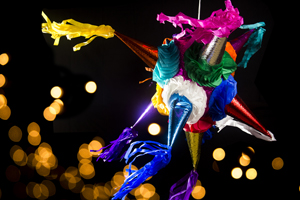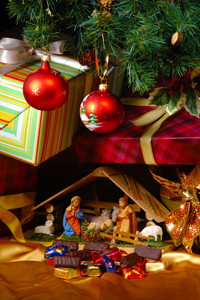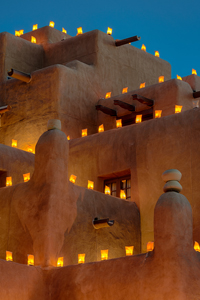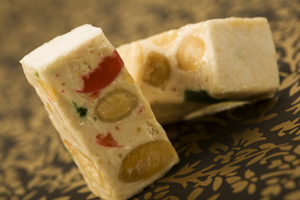When twinkling lights illuminate presents under the tree and carolers are singing with holiday cheer, that means only one thing…Christmas is here! The holidays are a time to spend with family and friends, as we celebrate and exchange cultural traditions with one another. In Latin America, Christmas is celebrated with candles, sweet treats, services, and even fireworks. Read on to see how you can incorporate some Latin flair into your holiday celebrations.
Christmas in Mexico
Celebration: Mexican Christmas festivities begin on December 12 with the feast of La Guadalupana (Virgin of Guadalupe), and ends on January 6, with the Epiphany. In between these dates, other festivities include Holy Innocents Day and the main celebration Las Posadas, which lasts for nine days, from December 16 until Christmas Eve.
Traditions: Every year, Mexicans celebrate Las Posadas, which means accommodations, by re-enacting the story of Joseph looking for shelter at the inn. Even the kids get in on the fun and join in the procession, as everyone sings traditional songs and prayers. After the pageant, Mexicans get the party started with sweet treats, Christmas music, and of course, breaking out the piñata!
Food: A traditional meal of romeritos (baked shrimp), bacalao (dried cod fish), roast turkey, and a variety of salads are served for dinner. But it is the popular dessert throughout Latin America known as buñuelos that everyone eagerly awaits. Buñuelos are fried balls of dough that are dredged in a syrup of cinnamon and sugar, or dimply dusted with powdered sugar. They are usually served during Las Posadas.
Next, Christmas in El Salvador and Venezuela…
[pagebreak]Christmas in Venezuela
Celebration: The unofficial start of the Christmas festivities is after the celebrations of Feria de la Chinita, which occurs in the second half of November. This festival, with various religious activities, processions, and music, is meant to celebrate the Virgin Mary of Chiquinquira or La Chinita as she is known as here. Then on December 16, Venezuelans take out their mangers and attend daily church services until the 24th. This service is called Misa de Aguinaldo (Early Morning Mass), and in the capital city of Caracas, it’s customary for church goers to roller-skate to service.
Traditions: On the morning of January 6, children awaken to the sight of gifts, letting them know that the Magi and their camels have visited and returned home. The children then run to the mirror to see if there is a black smudge on their cheek, meaning that one of the Magi, Balthazar, had kissed them while they slept.
Food: Venezuelans love to stuff their dinner. Expect to see ham filled bread with olives and raisins; ensalada de gallina, a salad made of potato, carrot, apple and shredded chicken; and traditional hallacas, a rectangle shaped meal of maize filled with beef, pork, olives, raisins and caper, and wrapped in green plantain leaves. Yum!
Christmas in El Salvador
Celebration: Family is the center of Christmas in El Salvador. Gatherings usually begin at 7 at night, when families arrive with plenty of food and stories. The holiday is celebrated with candles, fireworks, and fountains. A banquet dinner and presents at midnight on December 25 closes the Christmas celebrations for the evening.
Tradition: It is a tradition amongst Salvadorians to “pass through” the houses of several friends first, before arriving at their families’ house for Christmas. Another explosive tradition is the role of fireworks during celebrations. These estrellitas are set off at midnight, when everyone is full of food and cheer, as they head to the Misa de Gallo or Christmas Mass. Before guests say goodbye to their family, it is tradition to place the Baby Jesus from the Nativity under the tree, marking the day when the Christ Child was born.
Food: Some families in El Salvador enjoy an Americanized version of Christmas dinner including turkey or ham, while others have chicken and tamales. A variety of cakes and wines are served as dessert, while children enjoy horchata, a mix of pulverized milk, cocoa beans, and pumpkin seeds.
Next, Christmas in Colombia and Brazil…
[pagebreak]Christmas in Colombia
Celebration: The unofficial start of Colombian Christmas festivities takes place on December 7, which is known as Dia de las Velitas or Day of the Candles. On this day, families light velitas in honor of the Virgin Mary. This event honors the Immaculate Conception, which the church celebrates on December 8. From December 16-24, Colombians decorate their Christmas trees with lights and bowls, set up a Nativity of clay figures called pesebre, and sing Christmas carols as a family.
Traditions: Instead of Christmas lights, Colombians use candles for a holiday glow. Each home is illuminated with about 100 candles, which line curbs and sidewalks in a decorative fashion. On Christmas Eve, everyone waits until midnight to wish each other a Merry Christmas and exchange gifts. When it’s time to give out presents, they are brought by Baby Jesus, not Papa Noel, and they are not placed under the tree, but at the foot of children’s beds.
Food: On a holiday dinner menu in Colombia, you will find ajiaco, a delicious soup with potatoes, the chicken, vegetables, and tamales. Cena de Navidad will also feature hojuelas, a fried pastry made with orange zest; natilla, a corn based dessert; and brevas caladas, cooked figs served with white cheese on the side.
Christmas in Brazil
Celebration: Perhaps the most similar celebration to Christmas in America, Christmas in Brazil is marked with church services, exterior decorations, and special family meals. They decorate their homes with large Christmas displays called presepios, which include Christmas trees, lights, colorful flowers, and a large straw bed where the Christ Child slept.
Traditions: Brazilians enjoy watching and participating in a play that tells the story of the Christ Child. What’s unique about Brazil’s version of the story is that the shepherds are female gypsies who want to kidnap the baby. According to legend, Papa Noel is not dressed in his typical winter garb, but in a red silk suit due to the Brazilian summer heat. A common tradition among Brazilians is amigo secreto, which is similar to our Secret Santa.
Food: Most Brazilians choose to feast on roast turkey, vegetables, and fruits, while others opt for chicken and rice as their special dinner. For desserts, Brazilians love their chocolate cake, Pannetone, and of course, Brazilian nuts.
Next, Christmas in Spain…
[pagebreak]Christmas in Spain
Celebration: Christmas is a very important religious holiday in Spain. The Virgin Mary serves as Spain’s patron saint. Similar to Christmas in Colombia, Christmas season in Spain officially begins on December 8 with the feast of the Immaculate Conception. The celebration occurs in front of the Gothic Cathedral in Seville with a special ceremony called Los Seises, or the dance of six.
Traditions: Los Tres Reyes Magos (known as the Three Kings or Magi), are well-regarded in Spain. Many believe that the Magi travel through the countryside, journeying to Bethlehem yet again. Children lend a helping hand by leaving their shoes on the windowsill, filled with straw, barley, and carrots to feed the horses. Children traditionally receive their gifts on the day of the Epiphany, the very last day of celebration.
Food: Nochebuena, or Christmas Eve, is met with family, friends and plenty of food, as this is the big meal for the Spanish. The Christmas feast is only eaten after midnight. A meal of roasted meats, typically pernil, fish soup, and a variety of cheeses are among some of the many delicacies. But the stars of the evening are the Spanish sweets. Turrón, a traditional almond candy and mantecados, a traditional Spanish crumble cake, are popular desserts.
Will your Christmas celebration include some Latin touches? Tell us on Twitter or Facebook, what are your holiday traditions?










![Making Mealtime Matter with La Familia: Easy Sofrito [Video]](https://thelatinkitchen.com/wp-content/uploads/2015/10/sofrito-shutterstock__0-500x383.jpg)
![Easy Latin Smoothies: Goji Berry Smoothie [Video]](https://thelatinkitchen.com/wp-content/uploads/2015/12/goji_berry-shutterstock_-500x383.jpg)
















![Fun and Fast Recipes: Fiesta Cabbage Salad [Video]](https://thelatinkitchen.com/wp-content/uploads/2015/11/fiesta_cabbage_slaw-shutterstock_-500x383.jpg)





